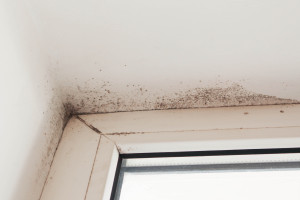
One of the things we dread to hear the most when it comes to our properties is that we have damp. Some people even choose to ignore the problem completely but living in a house with mould can be incredibly bad for your health.
What’s more, the worse the situation gets, the more it’s going to cost you to remove and repair any damage so it’s better to face up to the problem sooner rather than later.
What is damp?
Damp is the presence of moisture and water where it shouldn’t be – such as on the inside of walls and rising from the floor.
The three most common types of damp that can affect your home include rising damp, penetrating damp and condensation.
Rising damp is caused by ground water moving up through a wall or floor. Although most walls and floors will allow some water in, it’s usually stopped from causing damage by a barrier called damp-proof membranes.
Penetrating damp is caused by water leaking through the walls. It may expand across your walls or ceiling but will always do so horizontally rather than by travelling up walls. This is usually caused by structural problems such as faulty guttering or roofing, cracks in the walls or internal leaks. Survey your property from outside checking for leaky gutters, holes in your roof and cracks in your brickwork. Don’t worry if you have an older property that has cast aluminium guttering systems which needs parts replacing. There are several online guttering suppliers of cast aluminium ranges who will be able to advise you on how to replace and match your existing guttering.
Condensation is the most common type of damp and it’s caused by moist air condensing on walls. Typically, it occurs in rooms where there is a lot of moisture such as in kitchens and bathrooms and it’s often a winter problem because at this time of year, walls are much colder than the air outside.
Signs that you may have damp
Some of the more obvious signs of damp include:
- When you hang your clothes out after a wash, they won’t dry properly
- There’s a constant musty smell in your house
- Your breathing doesn’t feel right. It can even make asthma symptoms worse.
- You may see visible damp patches that come and go depending on the weather conditions
- Water droplets on windows or walls
- Mould starts to appear
- Signs of rising damp include damage to skirting boards or plaster as well as peeling paint and wallpaper – often with wet patches. You may also notice tide marks along your wall
- A general chilly or damp feeling in the house
- Damp floor tiles
- Algae and mould on external walls

How to prevent damp
There are a number of ways you can prevent damp from occurring in the first place or getting worse if you already have it:
- Poor ventilation exacerbates the situation so make sure your house (especially the bathroom) is well ventilated. Opening windows and having an extractor fan can be a big help.
- Rather than setting your heating to turn on and off at particular intervals throughout the day, it’s better to have it on constantly at a lower heat. Heating that comes on and off allows warm, damp air to condense.
- Use a damp-proof membrane. Impervious to water and laid under concrete floor, this can help to effectively seal and protect your house from ground water.
- If you’re thinking about buying a property and you suspect it could have a damp problem, a decent survey will be able to pick up on any issues. If it’s very obvious there’s damp, it’s advisable to ask an expert to assess how much it might cost before you pay for a survey. Visit the Royal Institute of Chartered Surveyors for more information – https://www.rics.org/uk/surveying-profession/what-is-surveying/
For more information on how to deal with damp problems in your home visit: https://www.which.co.uk/reviews/damp/article/dealing-with-damp/what-kind-of-damp-is-affecting-my-home-arNnf1P2wVnV
